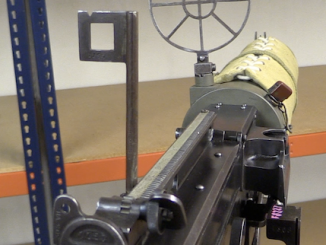The Ottoman Empire purchased a staggering number of Mauser rifles over many decades, and Turkey would update many of them to a standardized pattern in the 1930s. This particular example is very rare, with an attached folding bayonet.
The base rifle here is (was) a 1903 model Mauser carbine, chambered for the 7.65mm Mauser cartridge. Starting in 1930, these were updated to chamber 8mm Mauser ammunition, given longer barrels, and in this case, that folding bayonet. We can see evidence of the gun’s past in the receiver notch necessary for the longer 8mm cartridge, and the residual Turkish numbers, which predate the transition to Arabic numerals in 1928/29.
This rifle is part of Lot 794 at Rock Island on Thursday, October 8th.




Right about the time I’m thinking I’ve handled every type Mauser available, along comes Ian…..
While it is the SAAMI designation, using “8 mm Mauser” for the German infantry cartridge is misleading, because Mauser was not involved at all in its development. The popular use to say “7.92 mm”, as invented in Czechoslovakia after production was started there 1918, is doubly misleading. First, in Turkey this caliber was named officially “7.9 mm”, as in other user nations like Yugoslavia or China. Second, caliber 7.9 mm is indeed the figure used in Germany from its inception in 1888 to the end in 1945.
wow I thought that most people who think they knew a thing or two about firearms&ammunition know the absolute truth about it when in reality there just a bunch of ignorant Dumass’es who don’t know shit!!!!!!!!!!!!!!!!!!!!!!!!!!!!!.
A series on ALL Ottoman breech loaders would be very interesting.
It is reputedly the ottoman use of Martinis for long range then Winchester lever actions for short range during two Tzarist attacks at Plevna, which woke up the European power to the possibilities of repeating arms for military use.
It seems that the Tzar’s generals needed to go through with the second attack to convince themselves that, yes, the Ottomans really had slaughtered the lot.
A bit like today’s politicians – yes, the first lock down really did do more damage to the economy than anything since the napoleonic wars, and for zero benefit, but you need to repeat the mistake and hope for a different outcome the second time?
There’s a name for that.
Anyway, however economically and morally corrupted the Ottoman Empire and it’s successor regimes might have been, they were (and still remain) complete fashion victims when it comes to armaments.
I’d be very interested to see examples of the Turkish Martinis, especially those that had there receivers bolstered and fitted with rimless extractors for conversion to 7.65mm (and perhaps 7.92mm as well.
Incidentally, I think that “short” mauser 98 actions are still highly prized for Bubbaficationating.
Keith:
Agreed about the lockdowns, we seem to be ruled by stupid don’t we?
I think the Turks made a mistake going for 7.92mm, the 7.65mm is a much more civilized round. Furthermore, the sight picture on this rifle is terrible. Is that the smallest notch ever? Or did the Turks all have eyes like cats?
Stupid question: What kind of bayonet moves could you do since the blade edge is horizontally oriented as opposed to vertically oriented? You can stab someone but withdrawal must be awfully awkward… I could be wrong.
The plusses and minuses of various styles of bayonets is always interesting.
With a folding bayonet, it never gets lost, but it is always exposed to the elements too.
Spike bayonets always seem to work better as bayonets than knife style bayonets. A lot of the knife style bayonets don’t make for very good knives either.
Then there is the issue with rifles of change in the point of bullet impact when the bayonet is fixed to the muzzle. Are folding bayonets less subject to this problem than conventional bayonets?
All in all, I think the bayonet system the French used on the MAS 36 rifles is the most logical of them all.
One thing I wonder about with this Turkish Mauser folding bayonet is muzzle blast. When the bayonet is fixed forward, would the flat shape under the muzzle tend to deflect muzzle blast that could stir up dust when firing in the prone position or otherwise when firing low to the ground?
Hello,
thanks again for this interesting gun. Nevvertheless you said that the receiveris shorter. The receiver has the same length as the “sandard” Mauser but the front bridge goes farther backwards and the bolt is yes shorter. The spacing between fixation screws is the same, an easy way to check. The lever has not a ball end but a pear. The under part of the receiver tail is slightly different. This is also the peruvian 1909 action.
I recently acquired serial #42. Oddly enough, I had bid on serial # 46 at the RIA auction you mentioned but got outbid, not knowing you had done that above video on it (excellent info by the way, very much appreciated the insight!). Several months went by and #42 came up for a good price so not I have it. Still wondering why and for whom the Turks made these folding bayonet models? Love to see a full-on Turk Mauser Ian-fest, love the historical aspect of things! Thanks